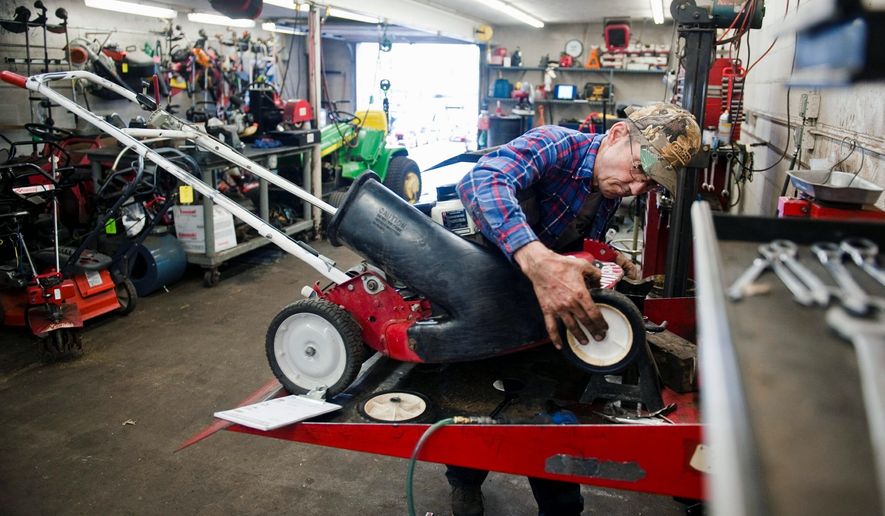(THE ETHANOL ECONOMY: Part of an occasional series)
Manufacturers of lawn mowers, snowblowers, chainsaws, and other small-engine equipment continue fueling a debate over the supposed dangers of ethanol, but the ethanol industry argues that they are merely looking for a scapegoat to mask operator error.
Gasoline blended with ethanol has become commonplace for American drivers, especially since Congress enacted the 2007 Renewable Fuel Standard and began mandating increasing amounts of the fuel at gas pumps across the country. Critics argue that while such blends — including the most common, E10, which combines 10 percent ethanol with regular gasoline — pose no problems for automobiles, they can often wreak havoc on small engines.
Those problems become even worse, they say, with higher ethanol blends such as E15.
“You’re putting alcohol into the fuel. They’re different atoms. They don’t like to stay married,” said Kris Kiser, president and CEO of the Outdoor Power Equipment Institute, the leading trade group for power equipment and utility vehicle manufacturers. “This is a big deal, and everybody wants to downplay it. But we’re pretty sensitive to it.”
One of the key issues, Mr. Kiser and others argue, is how rarely much of the small-engine equipment is used. While automobiles run through tanks of gas relatively quickly, lawnmowers and other small machinery often contain the same gasoline for weeks or months.
Over time, the ethanol attracts moisture, separates from the fuel, and causes serious engine problems, steering car owners to repair shops.
“Sometimes a customer will have an issue and it’s not covered under warranty because it’s a fuel storage issue,” said Terry Ditsch, vice president of product service at Echo USA, one of the nation’s leading small-engine products manufacturers.
Like a host of other companies, Echo has produced a guide sheet warning customers to avoid any ethanol blend higher than E10 and urging them to take extra precautions when using gasoline blended with ethanol.
Some companies even offer specially designed fuel that is entirely free of ethanol.
Both sides of the debate point to studies that seem to prove their points, though anecdotal reports of engine problems have skyrocketed since ethanol has become more prominent, Mr. Kiser and others say.
Ethanol proponents say most of the problems in small-engine equipment can be traced back to simple mistakes by the owner, not any inherent problems with ethanol itself.
“You can bring it into a mechanic and he says, ’Do you use ethanol? There you go, that’s the problem,’ without having ever diagnosed it,” said Donn Larson, the CEO of Larson Sales in Hudson, South Dakota, a wholesale distributor of outdoor power equipment.
“You put fuel in there and ethanol gets blamed. It’s easy,” he added. “And people buy into it in droves. But speak to them, ask them where they got their information and why they think ethanol is a problem, and they typically can’t answer you.”
Mr. Larson and other ethanol backers contend that owners either allow fuel to sit too long in their equipment or use a blend that is incompatible with their products. A 15 percent ethanol blend, for example, isn’t suited for some older pieces of equipment.
Others see the Outdoor Power Equipment Institute and other critics as unwitting agents of the oil and gas industry, which long has opposed federal ethanol mandates and increased use of the fuel. The small-engine complaints, they say, are just pieces of a broader war against ethanol.
“We’re a threat, and that’s not compatible with the status quo,” said Doug Berven, vice president of corporate affairs at POET, a South Dakota-based biofuels company. “From an ethanol industry [perspective], what we want is to offer choice to the consumer. We would like to see all different types of fuel blends at a pump so a consumer always has the best value.”
But whether consumers fully understand the choices they are getting remains an open question. E15, for example, has been federally approved for automobiles made in 2001 or later. Using the blend in vehicles older than that could lead to engine problems.
Mr. Ditsch and others argue that customers simply may not pay attention to the specific type of fuel they are using, especially if they are accustomed to filling up with the cheapest choice at the pump.
“The problem is you’ve got this little sticker nobody pays attention to,” he said. “This thing with E15, where it’s available but it’s not really for small engines — you’ve got a disconnect between what’s available in the marketplace and the general public’s understanding of where it can be used.”
• Ben Wolfgang can be reached at bwolfgang@washingtontimes.com.




Please read our comment policy before commenting.